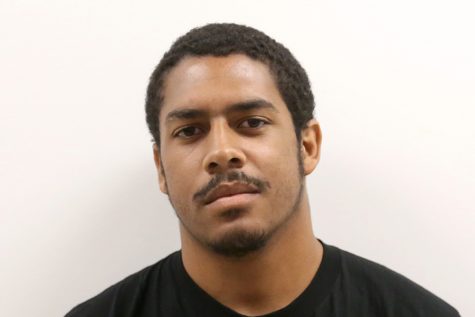Satire depicts Hispanic stereotypes
Diego Loza (left), Jelaine Maestas (middle front), Gregory Lee (middle back) and Andrea Flores (right) raise a glass of champagne during a scene from “The Hispanick Zone.”
May 1, 2019
The drama department has nailed it again for the second year in a row while continuing to bolster connections with the Latino community in the final production of the academic year “The Hispanick Zone.”
Running the weekends of April 19 and 26, this hilariously irreverent play combines colorful sets and costumes with a sharp script and solid performances creating an evening of theater that even non-Latino audience members can enjoy.
Directed by drama department Chairperson Carlos-Manuel Chavarria, the structure of “The Hispanick Zone” follows a format similar to “The Twilight Zone,” from which it drew significant influence.
A selection of short scenes play out in strange alternate universes where twists are quick to come by.
Each scene takes an exaggerated look at parts of various Hispanic cultures.
There are several scenes that could fit straight into an episode of “The Twilight Zone,” which are some of the best. The over-the-top way these scenes examine society is hilarious while also thought-provoking.
One scene shows three television executives in a meeting wondering if the world is ready for a minority television star. As their conversation unfolds, it becomes clear that this reality is a Latino majority and they’re deliberating the viability of a white star in their show.
The absurdity found in this scene really shows the ridiculousness of real-life companies having that same meeting when it comes to casting Latino actors.
Another great scene was that of Southern politicians trying to diversify their voting base by appealing to “Maria,” a mannequin they own to represent the Latino voting base.
Their racist language while trying to strategize how to gain the Latino vote is uncomfortably real. There’s truth to all the humor in this play.
While a lot of the humor in the performance is relatable to audience members from any background, some jokes hit specifically hard toward the Latino members of the audience.
Certain scenes like a construction worker, played by Diego Loza, speaking in hilariously exaggerated English to appear more American is approached by his boss and co-workers to speak in simpler English because that’s what expected of him.
While the base level joke is clear to everyone, there were specific nuances and jokes that got a laugh from Latino audience members.
One scene managed to steal the show bringing out the ensemble to act out a telenovela. A telenovela is a soap opera produced in Latin America and is stereotypically marked by overly dramatic love stories and plot twists — something this scene had in abundance.
The scene was a whirlwind of energy and twists that received some of the heaviest laughs in the show.
Most people can relate to seeing the wild scenes from telenovelas, so it was a scene that did a great job bridging cultures.
The play took a while to get going with some opening scenes like “language for lovers,” a monologue by Silvia Sobal playing La Doctora. She led the audience in a lesson on how to approach lovers by shouting “mamacita” and “papasote.”
The scene is funny, but the play gets stronger and excels as the ensemble gets the chance to play off one another.
The final scene is an interesting one with a beauty pageant led by Chavarria as Latina Turner. She introduces the contestants Mr. USA, Mr. Venezuela, Mr. Bolivia, Mr. Puerto Rico, Mr. Panama, Mr. Mexico and Mr. Nicaragua.



